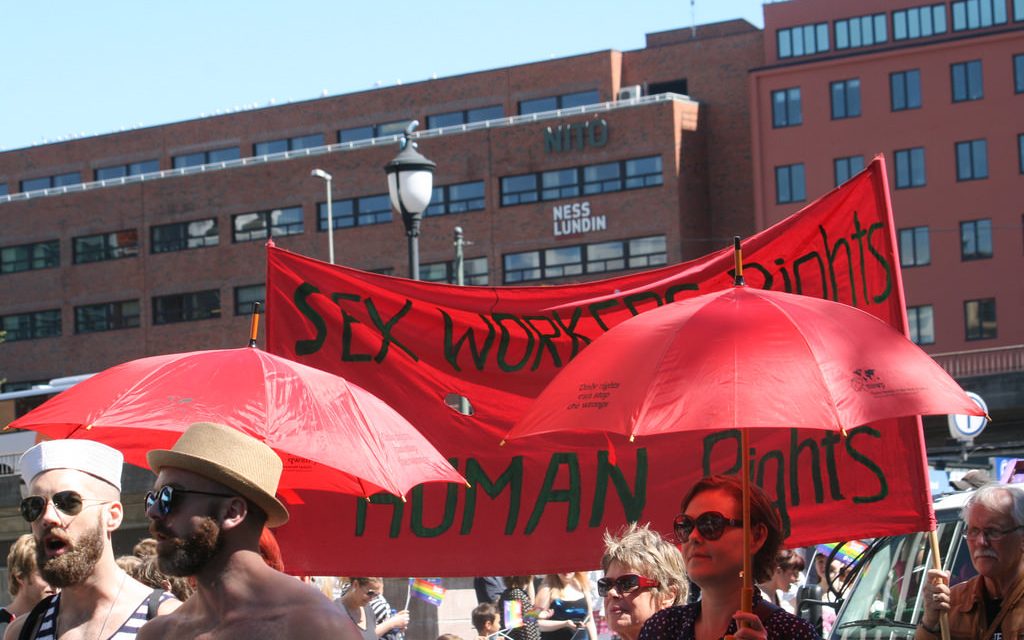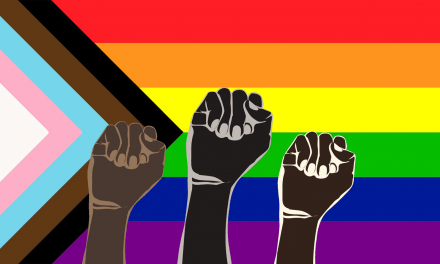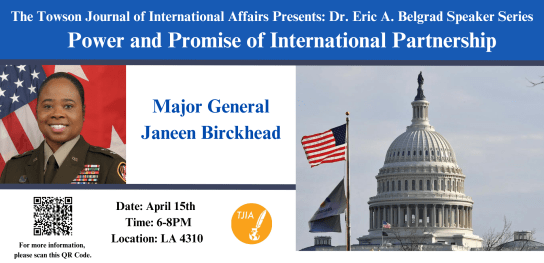The sex industry is massive, global, and exists in both the regulated, transparent world and the underground black market. Sex trafficking has been identified as an issue to address by government agencies and international organizations that tackle illicit transnational trade flows, national and international security issues, and most prominently, human rights. Unfortunately, domestic policies are often flawed and only further endanger the people who populate the sex industry. As trafficking has been targeted as an element of the sex industry, research about its nature and prevalence has adopted distorted and ill-informed approaches, fueling anti-sex work sentiments and oppressive policies that further endanger trafficking victims. The conflation of sex trafficking and sex work not only undermines the rights and safety of sex workers, but further drives trafficking underground and reduces resources for help.
On March 21, 2018, the United States Senate overwhelming passed an anti-sex trafficking bill that is intended to allow victims to seek legal action against websites that advertise for prostitutes.[1] The bill was created when Congress became aware that anti-trafficking laws do not apply to websites like Backpage, which posts ads for commercial sex, the providers of which are purportedly trafficked. The “Stop Enabling Sex Traffickers Act,” or SESTA, and its version in the House of Representatives, “Allow States and Victims to Fight Online Sex Trafficking Act of 2017,” or FOSTA, which passed on February 27, 2018, amends the Communications Decency Act. CDA protected websites like Backpage from liability for ads posted by third parties. With FOSTA/SESTA, actions could then be made against websites that “knowingly [assist, support, or facilitate] a violation” of federal sex trafficking laws.[2] The 388-25 House vote and 97-2 Senate vote reflects an ardent desire to rescue those who are enslaved to exchange sex but lacks comprehension of the sex industry and may only harm those that it is intended to help.[3]
This dangerously broad legislation conflates consensual sex work with sex trafficking, which manifests many issues. FOSTA/SESTA encompasses the “promotion or facilitation of prostitution” and targets anyone who “uses or operates a facility or means of interstate or foreign commerce,” extending well beyond trafficking situations and making consensual sex work a federal crime.[4] It is well-known that prostitution is dangerous work in any country, with its workers experiencing higher rates of violence, HIV/AIDS, and more.[5] Consequentially, the internet has become a crucial component of harm reduction in the sex industry. The wording of these acts is so broad that it includes the provision of safety advice and platforms to screen clients. The use of websites like Backpage to post ads allows for customers to be vetted by allowing contact via phone or text before meeting. Some websites were created specifically for sex workers to research, review, and blacklist customers to maximize safety (which I will abstain from citing for reasons that I hope are obvious). When anyone – including prostitutes – are subject to civil and criminal liability for simply using these websites, interactions will move from the indoors to the streets, increasing vulnerability and the need for pimps for protection and to solicit clients. The absurdity of this is demonstrated by the FBI seizure and shutdown of Backpage on April 6, 2018. Seven of the site’s founders were indicted on 93 counts, but not even one of those counts uses the term trafficking; they are all primarily on the grounds of “facilitating prostitution” and laundering money.[6]
The public is experiencing a moral crisis over sex trafficking. As this crisis spurs new legislation, clear definitions are of increasing importance but still severely lacking. “Sex work,” or the “[consensual] exchange of [adult] sexual services, performances, or products for material consumption,” includes, but is not limited to, pornography, prostitution (including escorting, brothel work, and street prostitution), exotic dancing and lap dances, phone sex, webcam modeling, and more.[7] The supply of different types of sex work varies greatly across locations, catering to the cultures and laws that shape its demand. Each form exists in varying shades of legality or criminality depending on the body that governs it. The important takeaway is that the term implies agency and therefore refers to transactions that are voluntary.
The United States Department of Homeland Security defines sex trafficking as “modern-day slavery and involves the use of force, fraud, or coercion to obtain some type of labor or commercial sex act.”[8] While all forms of sex work become sex trafficking in the absence of consent, it is forced prostitution that is associated with sex trafficking. Some ways in which people are coerced into trafficking is by threats of violence; by having their ID or other critical documents withheld; by being persuaded, sold, or tricked by relatives or other close individuals for profit or to pay off a legitimate or illegitimate debt; and/or by being lured in by false advertisements promising lucrative work.[9] Trafficking is also quite variable; someone who is pimped out by a family member on the streets of her hometown falls under the same umbrella as someone who is captured and sold internationally as a slave to a brothel. Unfortunately, many of these victims are considered prostitutes by U.S. law enforcement and punished as such, demanding reexamination of legal definitions. Furthermore, some studies reveal that a number of those who escape trafficking return to their traffickers due to the lack of resources and opportunities to move forward.[10] There is a structural deficiency that fails to effectively aid those that U.S. laws are supposed to protect.
While seemingly straightforward, many call out the importance of the overlap between consensual sex work and trafficking, pointing out that they fall within the same industry, providing many of the same services to many of the same consumers. While I also despise overly simplistic models, I contend that this purported overlap is the more simplistic and counterproductive assertion, and is exaggerated and arbitrarily applied. Only some types of feminist literature identify forced and early marriages as inherently tied to the institution of marriage itself, for example, so advocacy groups seeking to abolish child marriage do not also seek to abolish consensual adult marriages. When considering sweatshop and child labor overseas or undocumented migrant labor at home, proposed solutions to exploitation, insufferable wages and poor working conditions do not suggest the elimination of work entirely, leaving countless people unemployed and only more helpless. In that same line of thinking, the moral argument that condemns the consumption sexual services does not also condemn the Nike shoes on its feet or the food on its plate. The examples are endless, indicating that opponents of the sex industry are capable of understanding the problems of painting solutions with too broad of a brush, but are too deeply affected by the stigma of the sex industry to hold it to the same standards.
The conflation of trafficking and sex work saturates research and media with inflated statistics and misinformation. This enforces a paradox: in order to help victims of the sex industry and make them safer, there must be more laws criminalizing it. Those laws then victimize them further, and the process feeds into itself. Referring to trafficking victims as prostitutes and vice versa reinforces the stigma of the industry, which only justifies and contributes to the conditions that make it toxic to begin with. Prostitutes are perceived to be victims by the public; they are impoverished, drug-addicted women who are coerced and abused by their pimps and want out but can’t leave, and there are countless statistics to support that view. The issue is that those statistics frequently derive from interviews with trafficking victims, not sex workers. Misleading claims, such as that more than 90% of prostitutes want to quit but are unable to, are founded on flawed methodologies.[11] Street workers, who solicit customers in-person from public spaces such as streets corners and comprise the vast majority of women incarcerated for prostitution, are estimated to account for only 10 to 20% of prostitutes in the U.S.[12] However, they are overwhelming the demographic interviewed for studies conducted on prostitution.
Statistics on sex trafficking vary significantly and inconsistently. In 2000, the State Department made a report on all types of trafficking, acknowledging that “no one U.S. or international agency is compiling accurate statistics.”[13] The report states that “700,000 to 2 million women and children are trafficked globally each year.” Just three years later, the figure increased to 4 million. Two years later, it dropped to 600,000 – 800,000 with no explanation. This phenomenon is common, but the claims are still taken seriously by the media and public.
One influential 2014 study, mentioned in the Washington Post and other outlets, makes wide-ranging claims about prostitution like the one previously mentioned. It intended to visualize the size and structure of the sex industry, but only interviewed 36 incarcerated street workers and twice as many incarcerated pimps.[14] Despite this, the study still identified escorting websites, including Backpage, Eros, and online “high-end” escorting services as “internet-facilitated trafficking” with no evidence to support the assertion. There are two primary consequences of this conflation: First, trafficking victims are treated as prostitutes, and are incarcerated and withheld from appropriate resources for being “criminal.” Second, sex workers are treated as trafficking victims, and have their means for income and methods to maximize safety targeted by law enforcement and legislation. In either case, the conditions for those in the sex industry are worsened in the name of saving them.
Children in the industry stir even stronger emotions but are subject to the same faulty research. One claim that has been touted in articles published by CNN, NBC, and numerous other news sites is that 100,000 to 300,000 children are held in sexual slavery in the U.S.[15] A study on the misuse of research reveals that this figure has been cited in 29% of the 41 books on sex trafficking it analyzed, making it one of three flawed sources used in 78% of the books.[16] The fluctuating State Department statistics explained earlier is also one of those three sources. This figure is an exaggeration that originates from the misinterpretation of a 2001 study of individuals under the age of 21 who are at risk of “child sexual exploitation,” the definition of sexual exploitation including “gay sex” for boys, “modeling, stripping, topless and lap dancing” for girls, and even “unwanted exposure to distressing sexual materials via the internet,” i.e. pornography.[17] A more revealing figure is that between 2008 and 2009, federally funded task forces investigated 2,515 suspected cases of human trafficking, only 248 of which the possible victims were minors.[18]
Another common claim is that the average prostitute enters the trade as a minor, which is a gross miscalculation. The claim originates from sources like the one described in the previous paragraph. It is sometimes asserted that the average prostitute enters the industry at the age of 13, which is a misinterpretation of a 1982 study that collected reports exclusively from underage prostitutes on first-time noncommercial sexual acts, including kissing.[19] The nausea invoked by the thought of underage sex workers problematizes sex work instead of their vulnerability as individuals who use the trade to escape poverty and abuse, overlooking the root of the issue while promoting surveillance and criminalization. This endangers all minors in the industry, including those who are trafficked. In 2014, D.C. was one of less than half of states to fix a law that treats child trafficking victims as criminals, sending them to juvenile detention centers.[20] The Trafficking of Minors Prevention Amendment Act (TMPAA), which was pioneered by a former child trafficking victim convicted for prostitution, grants immunity to minors involved in prostitution and requires law enforcement officials to refer them to services for human trafficking victims, among other things.
Since there has been little progress made in gathering accurate data due to the preconceptions that guide researchers in addition to the hidden nature of the industry, these shocking statistics on prostitution are not reliable. But time and time again, embarrassingly anecdotal and inaccurate claims are made on popular new sites. A 2011 Newsweek article, for example, referenced a 2004 study on street prostitution – once again, using street prostitution to represent all types of prostitution everywhere – by stating that prostitutes’ average age of death is 34.[21] The actual study, however, was averaging data of street workers who had been murdered – not all prostitutes in general.[22] Of the nearly 2,000 women tracked, fewer than 8% died after 33 years. The prevalence of these ideas is reflected in the January 2017 Women’s March on Washington. Sex workers’ rights were removed from the platform and only returned, modified, after intense backlash. The “Unity Principles” initially replaced the statement “solidarity with sex workers’ rights movements” with “solidarity with those exploited for sex and labor.”[23] This illustrates a key issue; the public supports those who are exploited for sex, but not those who experience violence and state-backed exploitation for selling sex.
If you’ll allow me to generalize in the face of flawed research, I believe it is safe to assume the following: First, the majority of prostitutes in the United States do not do business as street workers but as online escorts due to the greater degree of safety, among other reasons. Second, street work bares a significantly higher rate of trafficking than online services. If both are true, then the endless studies drawing conclusions exclusively from street work only represent a fraction of prostitution overall, and there is not enough evidence to support that there is an inherent overlap between trafficking and prostitution. If prostitutes are indeed suffering, then perhaps we should take steps to legitimize their work to end the violence and oppression against them, not further drive the industry underground. These misconceptions about the industry contribute to the stigma that criminalizes it. Criminalization and stigma then justify violence against sex workers and trafficking victims and throws them behind bars.
The United States falls behind much of the rest of the Western world in terms of sex worker rights. International organizations, however, have created radical new policies regarding the issue. While the diversity and nuances of the sex industry demands a diversity of nuanced solutions to aid those involved, many agree on one catch-all policy: decriminalization. In August 2016, Amnesty International published its policy on sex work, along with four reports on the matter in Papua New Guinea, Hong Kong, and Argentina, calling for the full decriminalization of sex work.[24] The World Health Organization, UNAIDS, the Global Alliance Against Traffic in Women, Human Rights Watch, and many other organizations are all in support of Amnesty International’s policy, along with those who trade sex. While trafficking must remain criminalized, the policy recommends the decriminalization of sex work based on evidence that shows that criminalization makes workers unsafe, offers impunity to abusers, and prevents workers from reporting crimes due to fear of being penalized. The policy asks governments to ensure sex workers “protection from harm, exploitation and coercion; the participation of sex workers in the development of laws that affect their lives and safety; an end to discrimination and access to education and employment options for all.”[24] When sex workers are provided safety, legal resources, and opportunities, trafficking is easier to identify and victims are better able to seek the help they need without persecution.
The United Nations has also begun to take on a pro-decriminalization approach. UN Women convened in September 2016 to discuss women’s economic empowerment, one topic being sex work.[25] The resulting Commission on the Status of Women report made a series of recommendations such as the following: sex work should be recognized as work and should be protected as such under the provider’s terms and conditions; ensure the access to health care and social protections to prevent discrimination via national laws and policies; treat sex worker organization as legitimate unions and associations, and incorporate them in collective bargaining frameworks and institutions; and decriminalize sex work, including the purchase of sex, while holding those who exploit people accountable. The following month, the lack of an explicit policy prompted UN Women to call for a “consultation seeking views on UN Women approach to sex work, the sex trade and prostitution” eliciting hundreds of responses and recommendations from sex worker advocates worldwide.[26]
The UN has not ignored the recommendations of organizations like Amnesty International. For example, in October 2017, the UN Committee on Economic, Social and Cultural Rights (CESCR) recommended Russia to decriminalize sex work in response to the advocacy of a Russian sex worker organization.[27] The organization cited the harsh impact of police raids on their lives, including increased risk of violence and STDs. The CESCR concluded to Russia that “sex workers face obstacles in accessing healthcare services owing to the criminalization of sex work, and are vulnerable to police violence, increased occupational risks, and to HIV/AIDS infection.”[27] Sex worker groups and organizations around the world have been advocating to international organizations to consider their rights, and it is beginning to show.
The advice of Amnesty International, the UN and other international organizations should be heeded. Domestic efforts to eliminate sex trafficking and protect sex workers have a long, hard road ahead of it. Lack of accurate and comprehensive research, the pervading stigma of sex work, and the fallacious conflation of sex work and sex trafficking are only a few of the barriers to confronting the problem. FOSTA/SESTA is the result of misguided, ill-informed policymaking, concealed in the noble disguise of ending trafficking. Decriminalization is not the only step that must be taken, but it is an imperative one, and it will only take place when consensual sex work is differentiated from trafficking.
[1] Mucha, Sarah. 2018. “Senate approves anti-sex trafficking bill.” March 21. https://www.cnn.com/2018/03/21/politics/sex-trafficking-bill/index.html
[2] H.R.1865.
[3] Mucha.
[4] H.R. 1865.
[5] The Global Coalition on Women and AIDS & World Health Organization. 2004. “Violence Against Women and HIV/AIDS: Critical Intersections.” Information Bulletin Series No. 3.
[6] Selyukh, Alina. 2018. “Backpage Founders Indicted on Charges of Prostitution.” April 9. https://www.npr.org/sections/thetwo-way/2018/04/09/600360618/backpage-founders-indicted-on-charges-of-facilitating-prostitution
[7] Weitzer, Ronald. 2000. Sex for Sale: Prostitution, Pornography, and the Sex Industry. New York: Routledge Press.
[8] “What Is Human Trafficking?” U.S. Department of Homeland Security. Accessed May 5, 2018. https://www.dhs.gov/blue-campaign/what-human-trafficking
[9] Kara, Siddharth. 2010. Sex Trafficking: Inside the Business of Modern Slavery. New York: Columbia University Press; Spruce, Hannah. 2017. “What is Human Trafficking?” February 15. https://www.highspeedtraining.co.uk/hub/methods-of-human-trafficking/; Trylch, Rebecca. 2017. “Help wanted signs lead to human trafficking concerns.” June 7. http://www.abc12.com/content/news/Help-wanted-signs-lead-to-human-trafficking-concerns-427080053.html
[10] Mehlman-Orozco, Kimberly. 2016. “What happens after a human trafficking victim is ‘rescued’?” July 29. http://thehill.com/blogs/congress-blog/judicial/289709-what-happens-after-a-human-trafficking-victim-is-rescued
[11] Soroptimist International of the Americas. 2014. “Prostitution is Not a Choice.”
[12] Lucas, Ann M. 1995. “Race, Class, Gender and Deviancy: The Criminalization of Prostitution.” Berkeley Journal of Gender, Law, and Justice.
[13] Weitzer, Ronald. 2007. “The Social Construction of Sex Trafficking: Ideology and Institutionalization of a Moral Crusade.” Politics & Society.
[14] Dank, Meredeth et al. 2014. “Estimating the Size and Structure of the Underground Commercial Sex Economy in Eight Major US Cities.” The Urban Institute; Sullivan, Gail. 2014. “Study sheds light on dark sex trafficking industry.” March 12.
[15] Carr, Bridgette. 2009. “Sex Trafficking: An American problem too.” November 25. http://www.cnn.com/2009/OPINION/11/25/carr.human.trafficking/index.html?eref=ib_us; Chang, Hetty. 2013. “Survivor of Sex Trafficking Speaks Out as Battle Against Crimes Continues.” May 29. https://www.nbclosangeles.com/news/local/Survivor-of-Sex-Trafficking-Speaks-Out-as-Battle-Against-Crimes-Continues-209443011.html
[16] Fedina, Lisa. 2014. “Use and Misuse of Research in Books on Sex Trafficking: Implications for Interdisciplinary Researchers, Practitioners, and Advocates.” Trauma, Violence, and Abuse 1-11.
[17] Estes, Richard J. and Neil Alan Weiner. 2001. “The Commercial Sexual Exploitation of Children in the U.S., Canada and Mexico.” University of Pennsylvania.
[18] U.S. Department of Justice. 2011. “Characteristic of Suspected Human Trafficking Incidents.” 2008-2010.
[19] Silbert, Mimi H. and Ayala M. Pines. 1982. “Victimization of street prostitutes.” Victimology 122-133.
[20] Hughes, Sarah Anne. 2014. “Council Approves Bill Offering Safe Harbor To Child Victims Of Sex Trafficking.” December 3. http://dcist.com/2014/12/council_approves_bill_offering_safe.php
[21] Bennetts, Leslie. 2011. “The Growing Demand for Prostitution.” July 18. http://www.newsweek.com/growing-demand-prostitution-68493
[22] Potterat, John J. et al. 2004. “Mortality in a Long-term open Cohort of Prostitute Women.” American Journal of Epidemiology 778-785.
[23] Rowntree, Angie. 2017. “The Women’s March on Washington Needs To Better Embrace Sex Workers.” January 20. https://www.huffingtonpost.com/entry/human-rights-include-sex-workers-rights_us_58806da0e4b0aa1c47ac287f
[24] 2016. “Amnesty International publishes policy and research on the protection of sex workers’ rights.” Amnesty International. May 26. Accessed May 6, 2018. https://www.amnesty.org/en/latest/news/2016/05/amnesty-international-publishes-policy-and-research-on-protection-of-sex-workers-rights/
[25] UN Women. 2016. “Report of the Expert Group Meeting on the CSW 61 Priority Theme: Women’s Economic Empowerment in the Changing World of Work.” EGM/WEE/Report.
[26] UN Women. 2016. Consultation seeking views on UN Women approach to sex work, the sex trade and prostitution. October 16.
[27] UN Economic and Social Council. 2017. Concluding observations on the sixth periodic report of the Russian Federation. October 16.
*Disclaimer: The content contained in the following material is the sole ownership of the author and does not reflect the views of the Towson University Journal of International Affairs nor Towson University in any respect whatsoever.






